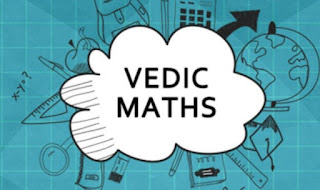VEDIC MATHS-97
VEDIC MATHS
By OMKAR TENDOLKAR
This is post number 97 from the series of "Vedic maths" blogs. Here in this blog we will learn about "Raising to Fourth and Higher Powers-I"
The expression on the RHS can be broken into two parts as given below. The first part has the terms a^3, a^2b, ab^2, and b^3 and the second part has the terms 2a^2b and 2ab^2.
(a)^4 + (a^3) b + (a)^2 (b)^2 + a (b^3) + (b)^4
+ 3 (a^3) b + 5 (a)^2 (b)^2 + 3 a (b^3)
------------------------------------------------------------------------
(a)^4 + 4 (a^3) b + 6 (a)^2 (b)^2 + 4 a (b^3) + (b)^4
- If we take first term (a)^4 and multiply it with b/a gives (a^3)b i.e second term
- If we take second term (a^3)b and multiply it with b/a gives (a^2)(b^2) i.e third term
- If we take third term (a^2)(b^2) and multiply it with b/a gives a(b^3) i.e fourth term
- If we take fourth term a(b^3) and multiply it with b/a gives (b)^4 i.e fifth term
- 2 gets multiplied by 3 to become 6.
- 4 gets multiplied by 5 to become 20.
- And 8 gets multiplied by 3 to become 24.
- From 16 we put down 6 in the unit’s place and carry over 1 to the next step.
- In the ten’s place, we add 8 + 24 + 1 (carried over) = 33. We put down 3 in the ten’s place and carry over 3 to the next step.
- In the hundred’s column, we have 4 + 20 + 3, this gives us 27. We put down 7 and carry over 2 to the next step.
- In the thousand’s place, we have 2 + 6 + 2 (carried over) = 10. We put down 0 and carry 1 to the next step.
- In the final step, we have 1 + 1 = 2.
- So our final answer is 20736.
In next blog we will discuss about "Raising to Fourth and Higher Powers-II".
We will meet very soon through our next blog. Till that stay connected, stay healthy and stay safe.
Thanks
for giving your valuable time.


Comments
Post a Comment